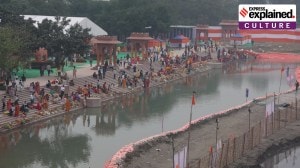Food for thought – Nuke technology will be used to store vegetables, spices
NEW DELHI, OCT 23: Fresh, germ-free and nuclear irradiated. Don't be surprised if you soon find onions, potatoes and some of the popular ...

NEW DELHI, OCT 23: Fresh, germ-free and nuclear irradiated. Don’t be surprised if you soon find onions, potatoes and some of the popular spices of Indian cooking sold under this tag in the market.
For, after Pokharan-II, the country’s nuclear technology is now tracking its path to the common masses. And the beginning is being made with the commodities which rule every Indian household — onions and potatoes. They may no longer have to rot in cold storages and primitive godowns due to inadequate storage facilities.
The Bhabha Atomic Research Centre (BARC) has made this possible. The Centre has almost completed the construction of India’s first two nuclear irradiation plants for preservation of onions, potatoes and spices. After years of debate in Parliament and scientific circles, the preservation plants will soon become operational under licence from the Minstry of Health.
Lasalgaon, the country’s onion belt at Nashik, will house a plant with a capacity of irradiating about 10 tonnes of potatoes andonions in a single minute. The second plant, ready at Vashi in Mumbai, will provide nuclear treament of spices against micro-organisms and pests at the rate of about 12,000 tonnes per year. “With this India will usher in an age of using highly advanced nuclear technology for processing and preservation of food,” says Anil Kakodkar, director, BARC.
Dismissing apprehensions about the handling of nuclear radiation for food items, he says,“It is safe. By normal method it is impossible to detect that the food has been irradiated. Even if we consider a hypothetical case of overradiation, the food will not remain palatable as it will be completely charred.” The irradiation technique will pave a way for preservation and processing of a huge quantum of perishable food commodities, which go waste due to lack of storage and disease treatment facilities.
Consider the case of onions and potatoes. Both show tendencies of sprouting. Once treated with nuclear irradiation, they can survive for as long as six to ninemonths at a wide range of temperature from 16 to 50 degrees Celsius. The nuclear treatment also rids the spices of contamination with germs and insects acquired during sun drying. “This is significant since the chemical fumigants are banned by several nations,” says Kakodkar.
BARC is not stopping at merely constructing the plants. The advanced nuclear technology is now available for adoption by Indian entrepreneurs. “BARC will extend all the technological support to the interested industries. If asked for, we will even construct the plants for them.” Cost? “They do not cost much — ranging from 5 to 10 crore for medium-sized plants irradiating a few thousand tonnes of food commodity per year. This amount is negligible in comparison to losses incurred due to spoiling of huge stocks of these commodities every year,” says Kakodkar.
Dispelling fears of mishandling of technology, Kakodkar says,“All the plants will be monitored by the Atomic Energy Regulatory Board. Besides they will run under licencefrom the Food and Drug Adminstration.” So, from fissions and subkiloton devices, the nuclear technology will now tread a path towards Indian households. Through onions and potatoes.



- 01
- 02
- 03
- 04
- 05




























